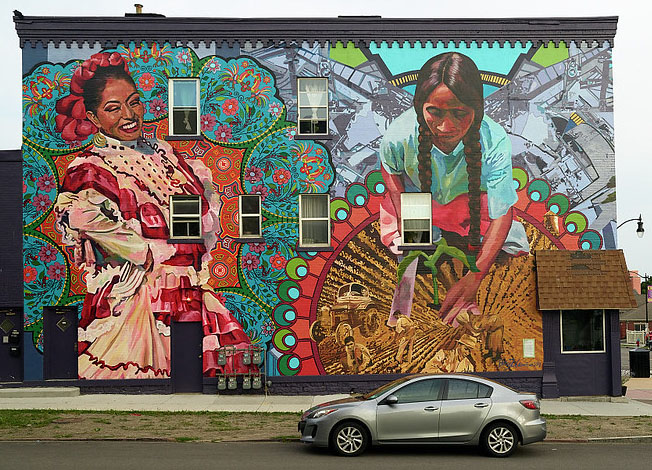To the Teacher:
In this activity, students will experience how a range of Latinx illustrators touch on language, identity, and self-expression through their comics – including an exploration of the meaning and significance of terms such as Latinx, Hispanic, Latino, and Latina.
This exploration isn't simple. We might pose such questions as, Why do we have to label our racial/cultural/ethnic identity to begin with? Who is this labeling done for? Do people see me in the way I choose to identify myself? Identity is complex, and so are labels.
Before 1970 in the United States, the government labeled people from Mexico, Cuba, and Puerto Rico (the three largest groups of Latin Americans in the U.S. at the time) as white. Latin Americans (who can be a mix of Indigenous, African, white, or other ancestries) were often clumped together, despite their varying cultures and dialects or languages. This wasn't working for the government or the people, so the term Hispanic was born. The word Hispanic has its critics, as do the words Latino/a and Latinx.

Introduction
Check in with the class. Ask:
- Who can share their understanding of the terms: Latino/ Latina, Hispanic, and Latinx?
Share with students this short clip, in which Netflix actor Isabella Gomez and friends break it down: https://www.instagram.com/netflix/p/Bot2r-ojDzO/
After viewing the clip, ask students:
- Do we have a better understanding of the terms: Latino/ Latina, Hispanic, and Latinx?
An Illustrator’s View
Share with students the illustration below by comic book artist Terry Blas. In it, he shares his understanding of the terms Latino and Hispanic.
https://www.vox.com/2015/8/19/9173457/hispanic-latino-comic
Ask students:
- What are your thoughts or observations about this comic?
- What questions do you have?
Terry Blas also created a comic about the word Latinx. Share it with students:
https://www.vox.com/the-highlight/2019/10/15/20914347/latin-latina-latino-latinx-means
Ask students:
- What are your thoughts or observations about this illustration?
- What questions do you have?
Comics: Small & Large Group Discussion
Teacher Preparation
Before class, look at the comics below, which are shared by The Latinx Project at New York University. Consider which comic(s) will be appropriate for and resonate with your students and your classroom environment.
- Stephanie Rodriguez:
https://www.latinxproject.nyu.edu/igualita-a-tu-mama
- Sharon Lee De La Cruz
The first 5 images of this: https://www.latinxproject.nyu.edu/im-a-wild-seed-race
You will have students work in small groups to consider and discuss one or all of these comics using a set of questions, below. (Please add or adapt questions according to your students and the classroom culture.)
Small groups might be structured in several ways, depending on your class:
- Share the comic(s) you have selected on the whiteboard. Have a few students come up to the board and volunteer to read the text to the class. Then have students discuss in pairs or small groups using the questions above.
- Print each comic for small groups (3 or 4 students). Have them experience the comics together and transition to discussion in the same groups, using the questions above.
- Print one of each comic and create four groups. Have each group start with one comic. All comics will get passed around until each group has experienced each comic. Have them stay in their groups for discussion, using the questions above.
Small Group Discussion
Share with students that because art can be a vehicle for the expression of all of our identities, we’re going to take a look at other artists who chose comics as a form of self-expression.
Tell the class that we will be looking at the works of these artists (or whichever artists you have selected):
- Stephanie Rodriguez is a Bronx-born comic book artist and illustrator
- Breena Nuñez is an Afro-Guatemalan-Salvadoran cartoonist living in San Francisco, CA
- Sharon Lee De La Cruz is a multi-disciplinary artist and activist from New York City
Explain your process for small group discussion.
Tell students that once their group or pair has had a few minutes to read and reflect on their comic, they will discuss the the comic using the following questions.
- Can I relate to what the artist is expressing?
- How does what the artist is expressing translate in my culture or community?
- What parts of my true identity are visible to others?
- What is my preferred creative outlet for self-expression?
- What would I choose to share using my preferred creative outlet for self expression?
Large Group Discussion
Invite students to share gratitude to the other members of their group for the sharing they have just experienced.
Ask the class to come back together into one group.
If time permits, have a go-around. Ask each student to share:
- What is your biggest takeaway from today's class?
If there isn't enough time for a go-around, invite a few voices into the space to share their takeaways with the entire class. If you (teacher) identify as a Latino/ Latina, Hispanic, or Latinx, please take a moment to share your experience with today's class as well.
Closing
Let's invite each other to celebrate the self-expression of these Latinx artists and of each other, embracing all of our identities and building connections beyond labels.
Additional Resource: For students who are interested in exploring the history of terms such as Latinx or Hispanic, or the history of Hispanic Heritage Month, consider sharing this episode of NPR’s Codeswitch podcast: https://www.npr.org/sections/codeswitch/